Musicarta Modes - Aeolian One
The Aeolian i–ëVII–ëVI
NOTE: Some computer
systems do not represent sharp and flat signs as entered by the author. ë indicates a flat sign and ì a sharp.
In this module, we’re going to expand the i–ëVII pair we’ve been working with in the two previous modules into a three-chord Aeolian minor riff you’re bound to recognize. This is the riff we build up to.
Download up-to-date MIDI files for this page
The i–ëVII–ëVI sequence
We’re going to add another major chord one whole tone below the i–ëVII pairs we’ve been working with so far, which makes the new chord ëVI (‘flat six’).
Listen to the familiar sound of this audio clip. The i–ëVII–ëVI sound is unmistakeable.
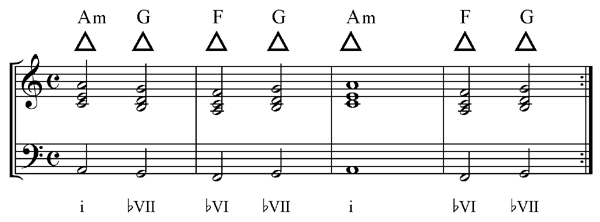
The roots of these next-door chords are a whole tone apart. (You want to know this so you can transpose the group of chords.)
- You have a minor chord – i
- A whole tone below that, you have a major chord – ëVII
- Another whole tone below that, you have another major chord - ëVI
Three-note chords (triads) can have any one of the three chord tones at the top. The chords in the first example are all first inversions (triangle symbol – root at the top). Here is the same chord sequence using second inversions as well (square symbol – third at the top)
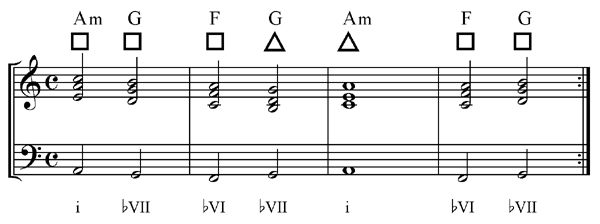
As you can hear, nothing is more natural than to start slipping between inversions. (Listen out for what the bass does in bar 3.)
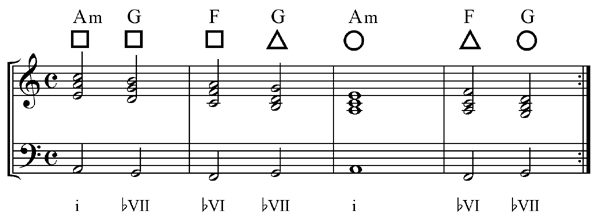
The one thing you want to avoid is using only root positions.
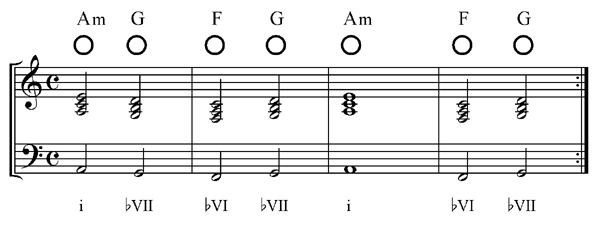
The outside notes are fifths, and this is too stark a sound to listen to for long. Besides, it sounds like you’ve never learnt your inversions! The audio clip tries to demonstrate this. (In classical music, these ‘parallel fifths’ are completely outlawed.)
The module riff
Listen to this i–ëVII–ëVI riff.
s You should recognise some of the techniques used from Module 5. The chords are broken up into broken chord patterns – including the ‘O’ for ‘outside’ (top and bottom) voices. There are other things going on as well – new tricks to make your chords go further. Let’s look in detail.
Here are the skeleton chordc.
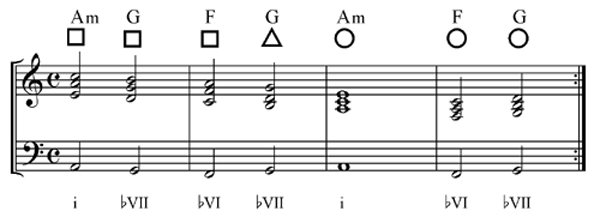
It’s made up of parts of the previous examples. You should be able to piece it together. If you don’t read music very well, use the circle-square-triangle symbols and the Musicarta Visual Glossary of chords or the illustrations with circle-square-triangle symbols in this workbook.
Her is a simple 'realisation' of the chord sequence.
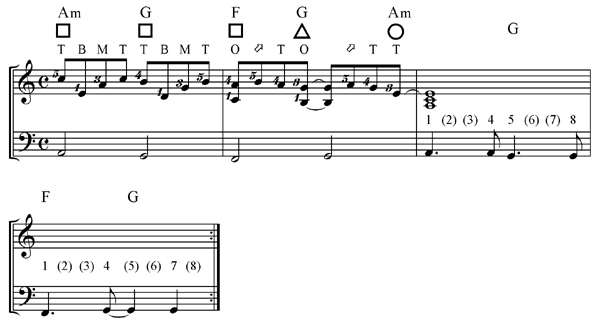
The ‘O’ in the BMT analysis stands for ‘outside’ – you play the outside two notes of the triad only.
Errata: Under the new system of crotchet counting. the last two bars would be marked up 1 (& 2) & 3 (& 4) | 1 (& 2) & (3 &) 4 |.
Adding next-door notes
But what are the ? question mark notes in the BMT analysis? They are next-door notes. The note next door to any chord tone (B, M or T) is always a good bet to try for filling up more quaver slots. Then, all you need to know is – is it above (higher) or below (lower)? These ‘question mark notes‘ are all above, so we can use an up arrow.
Our BMT analysis will then be as follows.

Refer back to the riff audio/MIDI to check the analysis.
As well as ‘O’ for ‘outside’, there’s a symbol ‘C’, for ‘chord’ – just play the whole chord on that beat.
The full set of BMT symbols is no\
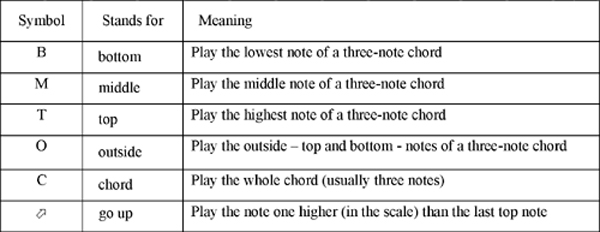
Notice two more things:
- Some chords are anticipated – played before their ‘straight’ beat. The chord symbols have been moved forward so that you can see, for example, that the second ‘O’ refers to the G chord.
- The last F chord is slimmed down to two notes, so ‘C’ (‘Play the whole chord’) only means two notes.
Adding the bass
Next, you need to look at how the bass (left hand) fits in with this right hand pattern. Read the following TLR (together, left, right) analysis carefully.
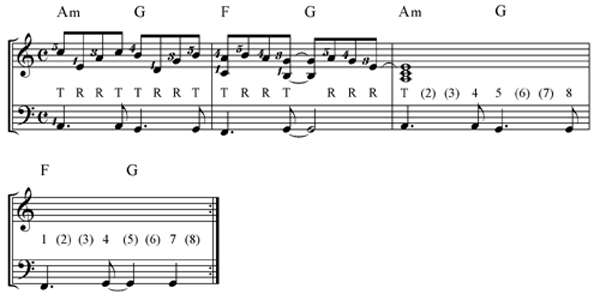
Because the right hand plays on nearly every quaver, it’s not too difficult to see when to play the left hand notes.
Practice just the right hand, first two bars. Fill up bars three and four practising just the rhythm of the bass – here counted in eight quavers.
Bars 3 and 4 - the rhythm
The rhythm of the last two bars is complex. There are melody notes at the top and an internal rhythm played by the left hand and the inside fingers of the right hand.
The first step is to drop the melody notes, and identify and practice the internal rhythm. Here’s the beat map of the two bars, without the melody.

If necessary, just tap the TLR (together, left, right) events regardless of rhythm.
T R L L R L T T R L
When you’ve got that, re-introduce the proper rhythm with just the ‘inside’ chords.
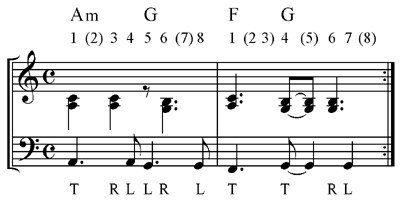
Modern keyboard solo style – right hand – often needs you to play or hold a melody note at the top and play rhythm chords underneath. Here’s a sample exercise for this key skill.
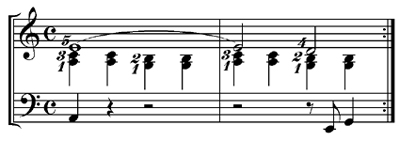
In case you’re not good at reading leger
lines, here’s that right hand written an octave higher.

Then the last bar as written.

Finally, the anticipated melody note E.

The full module riff is intermediate-to-advanced – you can expect to have to have to come back to it a few times. The upside is, this ‘messing about with chords’ slowly builds into an enviable creative skill, and the simpler versions of the riff you learn in the process (Musicarta’s ‘stepping-stone performances’) are good material in any event.
Finally, here’s the riff MS in full.
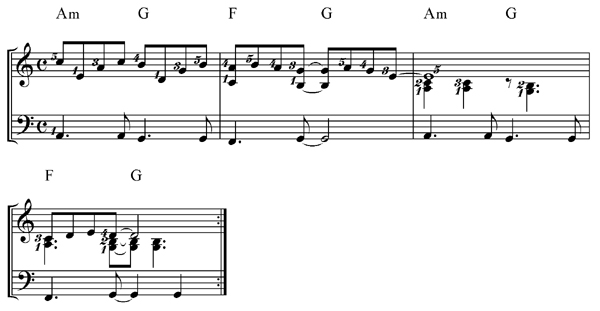
Listen out for the Aeolian i–ëVII–ëVI group of chords in popular music of all kinds.
In the next module in this series, we transpose the i–ëVII–ëVI group of chords into two different keys. Transposing is a ‘core’ musical skill. The more you transpose, the more you understand the inner workings of popular music harmony and the easier it will be to let your creative ideas flow.
|
OUT NOW! |
THE MUSICARTA BEAT & RHYTHM WORKBOOK At last! An effective approach to keyboard rhythm & syncopation skills. Learn more! |
ONLY $24.95! |
MODES |
The MusicartaA methodical approach to keyboard syncopation for
|
PUBLICATIONS
exciting keyboard
creativity courses
CHORDS 101
WORKBOOK

~HANON~
video course

Musicarta
Patreon
PENTATONICS
WORKBOOK
video course

Creative Keyboard
video course

BEAT AND RHYTHM
WORKBOOK

- Volume 1 -

12-BAR PIANO
STYLES WORKBOOK

MUSICARTA MODES
WORKBOOK

PIANO STYLE

CANON PROJECT
video course

VARIATIONS
video course


- Piano Solo -
video course

- Piano Solo -


YouTube playlists





 THE LOGO
THE LOGO
